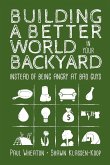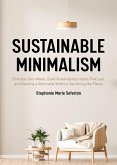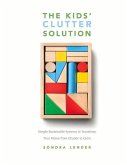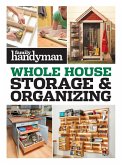- Broschiertes Buch
- Merkliste
- Auf die Merkliste
- Bewerten Bewerten
- Teilen
- Produkt teilen
- Produkterinnerung
- Produkterinnerung
Building a Sustainable Kitchen is the thoroughly researched and realistic step-by-step guide every climate-conscious cook needs to make the heart of their home more planet-friendly. When Canadian food writer Naomi Hansen first started a “sustainability” blog, she was overwhelmed by conflicting advice, shiny advertisements, unrealistic recommendations, and a culture of shame. Building a Sustainable Kitchen is her antidote: a solutions-focused, no-nonsense guide designed to help you cut through disinformation and greenwashing to make your kitchen truly sustainable, one step at a time. In each…mehr
Andere Kunden interessierten sich auch für
![Building a Better World in Your Backyard Building a Better World in Your Backyard]() Paul WheatonBuilding a Better World in Your Backyard16,99 €
Paul WheatonBuilding a Better World in Your Backyard16,99 €![Sustainable Minimalism Sustainable Minimalism]() Stephanie Marie SeferianSustainable Minimalism22,99 €
Stephanie Marie SeferianSustainable Minimalism22,99 €![Green House Green House]() Norm CramptonGreen House9,49 €
Norm CramptonGreen House9,49 €![Green Decorating & Remodeling Green Decorating & Remodeling]() Heather PaperGreen Decorating & Remodeling15,99 €
Heather PaperGreen Decorating & Remodeling15,99 €![The Kids' Clutter Solution: Simple Sustainable Systems to Transform Your Home from Chaotic to Calm The Kids' Clutter Solution: Simple Sustainable Systems to Transform Your Home from Chaotic to Calm]() Sondra LenderThe Kids' Clutter Solution: Simple Sustainable Systems to Transform Your Home from Chaotic to Calm26,99 €
Sondra LenderThe Kids' Clutter Solution: Simple Sustainable Systems to Transform Your Home from Chaotic to Calm26,99 €![Eco-Conscious Living Eco-Conscious Living]() Tristan EvergreenEco-Conscious Living12,99 €
Tristan EvergreenEco-Conscious Living12,99 €![Family Handyman Whole House Storage & Organizing Family Handyman Whole House Storage & Organizing]() Family Handyman Whole House Storage & Organizing15,99 €
Family Handyman Whole House Storage & Organizing15,99 €-
-
-
Building a Sustainable Kitchen is the thoroughly researched and realistic step-by-step guide every climate-conscious cook needs to make the heart of their home more planet-friendly. When Canadian food writer Naomi Hansen first started a “sustainability” blog, she was overwhelmed by conflicting advice, shiny advertisements, unrealistic recommendations, and a culture of shame. Building a Sustainable Kitchen is her antidote: a solutions-focused, no-nonsense guide designed to help you cut through disinformation and greenwashing to make your kitchen truly sustainable, one step at a time. In each chapter, Naomi invites you on her journey to build a planet-friendly kitchen, with help from her husband Paul and their dog Rue. Drawing on wisdom from hundreds of expert interviews, academic studies, books, and more, as well as on the author's own experience as a regular Canadian in her humble kitchen, Building a Sustainable Kitchen demystifies the science behind how what we do in the kitchen every day affects our Earth, and most importantly, shows you what you can do about it. Each chapter contains a wealth of flexible recommendations for achievable, evidence-based changes that make a real impact for the planet. Chapters on reducing food waste, understanding plant-based, local, seasonal, and organic eating, and gardening teach us about the food on our plates. Chapters on the potential and pitfalls of composting and recycling, learning what it really means to send waste to a landfill, and navigating the nitty gritty of disposable and reusable items help us reduce garbage and grow toward a circular economy. From water use, to cleaning, to choosing appliances, to our beloved coffees and teas, Building a Sustainable Kitchen leaves no stone unturned. This heartfelt, practical guide proves that building a sustainable kitchen is not just possible, but that it can also be joyful and transformative.
Produktdetails
- Produktdetails
- Verlag: Heritage Group Distribution
- Seitenzahl: 368
- Erscheinungstermin: 21. April 2026
- Englisch
- ISBN-13: 9781771514736
- ISBN-10: 1771514736
- Artikelnr.: 74980260
- Herstellerkennzeichnung
- Libri GmbH
- Europaallee 1
- 36244 Bad Hersfeld
- gpsr@libri.de
- Verlag: Heritage Group Distribution
- Seitenzahl: 368
- Erscheinungstermin: 21. April 2026
- Englisch
- ISBN-13: 9781771514736
- ISBN-10: 1771514736
- Artikelnr.: 74980260
- Herstellerkennzeichnung
- Libri GmbH
- Europaallee 1
- 36244 Bad Hersfeld
- gpsr@libri.de
Naomi Hansen is an author, writer, and editor. Her first book, Only in Saskatchewan (2022) was the winner of two 2023 Saskatchewan Book Awards-the First Book Award and the Book of the Year Award. She is a regular contributor for many publications, including Canadian Living and Chatelaine, and is also the Saskatoon Bites food columnist for CBC Saskatchewan. When she's not writing, Naomi enjoys reading, cooking, hiking, and travelling. She lives on Treaty 6 Territory in Saskatoon, Saskatchewan with her partner, Paul, and their dog, Rue.
Table of Contents
1. Foreword by Elizabeth May, Member of Parliament, Leader of the Green Party
of Canada
2. Introduction
* My Journey to Building a Sustainable Kitchen
* Understanding Sustainability
* Understanding Climate Change
* Why Food and Kitchens
* But Does Individual Action Really Matter?
* How to Use This Book
* The Journey Begins
3. Chapter 1: Food Waste
4. What Is Food Waste and Why Does It Even Matter?
* What Food Waste Costs Us
* What Food Waste Costs the Planet
5. What You Can Do
* Take Stock: Build Awareness of Your Food Waste Habits
* Take Stock Again: Check In with Your Fridge, Freezer, and Pantry
Regularly
* Plan Ahead, at the Store and at Home
* Understand Best-Before Dates
* Improve Your Food Storage Habits
* Table: Consumer Best Before Timetable
* Be Mindful of Food Waste Beyond Your Dinner Table
6. Takeaways
7. Chapter 2: Low-Waste Cooking
8. What You Can Do
* Learn to Cook Intuitively with What You Have
* Get Comfortable Substituting
* Use Foods in Their Entirety
* Find "Anything Goes" Recipes That Work for You
* Repurpose Leftovers to Create Something Even Better
9. Takeaways
10. Chapter 3: What We Eat
11. The Impact of the Global Food System
12. Plant-Based and Animal-Based Foods by the Numbers
* Chart: Greenhouse Gas Emissions Across the Supply Chain
13. Beef and Other Ruminant Animals
14. What About Local or Sustainably Raised Food? How About Packaging?
* Chart: Global Greenhouse Gas Emissions from Food Production
15. What About Fish and Seafood?
16. What About Dairy
17. The Prominence of Animal-Based Foods in Society
18. The Impacts of Plant-Based Foods
19. What You Can Do
* Shift Toward a Plant-Based Diet
* Take stock of Your Starting Point
* Invite Your Loved Ones into the Process
* Set Reasonable Goals
* Start with What's Easiest for You
* Learn to Cook with Plant-Based Protein
* Prioritize Progress over Perfection and Reflect on the Process
20. Takeaways
21. Chapter 4: Local, Seasonal, Organic
22. Eating Local
23. Eating Seasonal
24. Why Eat Local and Seasonal?
25. Eating Sustainably Looks Different in Every Climate
26. Eating Organic
* What Makes Food Organic?
* Is Eating Organic More Sustainable?
27. What You Can Do
* Reframe How You Think About Local and Seasonal Food
* Visit a Farmers' Market Near Your
* Subscribe to a CSA or Local Food Box
* Buy Your Animal-Based Foods Local and Organic
* Find Your Region's Unique Ways to Source and Support Local, Seasonal,
and Organic
28. Takeaways
29. Chapter 5: Grocery Shopping
30. The Principles Behind Sustainable Grocery Shopping
31. What You Can Do
* Create a Reusable Grocery Shopping Kit
* Find a Bulk Bin Store Near You
* Shop at a Zero-Waste Grocery Store
* Buy in Bulk to Save on Packaging
* Visit Individual Local Businesses
* Subscribe to a Food-Saving Produce Box
* Shop more Sustainably at a Conventional Grocery Store
* Bonus: Apply These Principles to Everything You Buy
32. Takeaways
33. Sidebar: Does Sourcing Food Sustainably Cost More?
34. Chapter 6: Composting
35. How Does Composting Work?
36. Why Composting Helps Create a More Circular System
37. What You Can Do
* Use Your Curbside Organics Collection Program—and Use it Well
* Advocate for an Organics Program Near You
* Choose a Home Composting Option
* Bonus: Understand Compostable Plastics—but Keep Them out of Your
Compost
38. Takeaways
39. Chapter 7: Recycling
40. A Brief History of Recycling
41. What Is Mechanical Recycling?
42. Which Materials Recycle Well?
43. The Challenge of Recycling Plastic
* Types of Plastic—and How They Affect Recycling
* The Economics of Recycling Plastic
* The Challenges of Composite Plastics
44. Understanding Recycling Labels
45. Our Obsession With Recycling
46. What You Can Do
* Go on a Recycling Tour
* Follow the Waste Hierarchy: Reduce, Reuse, Then Recycle
* Use the Recycling Services Available to You—and Use Them Well
* Do Your Homework for Hard-to-Recycle Items
47. Takeaways
48. Chapter 8: Garbage
49. Defining Waste
50. A Brief History of Garbage
51. The Grim Reality of Landfills
52. Linear Versus Circular Systems
53. The Zero-Waste Hierarchy
54. What You Can Do
* Replace Garbage with Landfill in Your Vocabulary
* Take Stock: Do a Kitchen Garbage Inventory
* Make Less Garbage
* Consider Your Garbage Bag
55. Takeaways
56. Sidebar: My Experience Making Less Garbage—and the Limits of Individual
Action
57. Chapter 9: Disposables and Reusables
58. Are Reusable Items Always More Sustainable?
59. The Zero-Waste Hierarchy: Zooming In on Refuse and Reduce
60. What You Can Do
* Refuse: Use Up What You Already Have—and Then See What Happens
* Implement the Zero-Waste Hierarchy in Your Kitchen
* The Waste Hierarchy Categories
* Learning to Think Zero Waste
* Aluminum Foil and Pans
* Dinnerware
* Drink Receptacles
* Paper Baking Products
* Paper Napkins
* Paper Towel
* Plastic Wrap of Cling Wrap
* Plastic Zip-Top Bags
* Straws
* Wax Paper
61. Takeaways
62. Sidebar: Share What Your Have
63. Chapter 10: Plastics
64. What Even Is Plastic? When Was It Created?
65. What Happens to Plastic Once It Becomes Waste?
66. Microplastics, Chemicals, and Us
67. Why Avoid Plastics
68. What You Can Do
* Take Stock: Do a Plastics Inventory in Your Kitchen
* Reduce and Avoid Plastics Moving Forward
69. Takeaways
70. Chapter 11: Coffee and Tea
71. The Environmental Impacts of Coffee
72. The Environmental Impacts of Tea
73. A Sustainable Morning Cuppa
74. What You Can Do
* Buy Coffee and Tea That are More Sustainable
* Take Stock: Clean Up Your Home Coffee and Tea Routine
* Deliberately Reject Disposable Coffee Culture
75. Takeaways
76. Chapter 12: Gardening
77. Building My Sustainable Garden
78. What You Can Do
* Start a Garden
* Take Care of the Soil
* Say No to Synthetic Pesticides and Fertilizers
* Harvest Rainwater
* Don't Buy a Bunch of New Garden Stuff
* Consider End-of-Season Practices
* Bonus: Rewild Your Green Space Using Native Plants
79. Takeaways
80. Chapter 15: Water
81. Water Use in Canada
82. What You Can Do
* Waste Less Water When You Cook
* Put Thought into Your Drinking Water
* Check Your Kitchen Sink and Tap
* Consider Your Dishwashing Habits
83. Takeaways
84. Chapter 14: Cleaning
85. What You Can Do
* Take Stock: Do an Inventory of Your Kitchen Cleaning and Dish
Products
* Opt for Greener Cleaners
* Try Cleaning with Household Ingredients
* Evaluate Your Dish Soap
* Evaluate Your Cleaning and Dishwashing Supplies
86. Takeaways
87. Chapter 15: Appliances
88. Appliances and Energy Consumption
89. Renewable Energy
90. What You Can Do
* Use the Appliances You Already Have More Efficiently
* Check for Phantom Power
* Buy Large Appliances That Are Energy Efficient
* Buy Small Appliances and Kitchen Gear Sparingly and Thoughtfully
* Repair Your Appliances
* Implement the Waste Hierarchy for End of Life
91. Takeaways
92. What’s Next? Building Sustainability Beyond the Kitchen
93. Sustainability in an Unsustainable Culture
* The Most Sustainable Actions Are Not Always What They Seem
* Individuals Can Make Sustainable Choices, but Systems Need to Catch
Up
* Sustainability Is an Ongoing Choice
94. What Is the Most IMpactful Action You Can Take From This Book?
95. What More Can You Do?
96. The Future Is in Our Hands
97. Acknowledgements
98. Resource List
99. Bibliography
100. List of Interviewees
101. List of Figures
102. Index
1. Foreword by Elizabeth May, Member of Parliament, Leader of the Green Party
of Canada
2. Introduction
* My Journey to Building a Sustainable Kitchen
* Understanding Sustainability
* Understanding Climate Change
* Why Food and Kitchens
* But Does Individual Action Really Matter?
* How to Use This Book
* The Journey Begins
3. Chapter 1: Food Waste
4. What Is Food Waste and Why Does It Even Matter?
* What Food Waste Costs Us
* What Food Waste Costs the Planet
5. What You Can Do
* Take Stock: Build Awareness of Your Food Waste Habits
* Take Stock Again: Check In with Your Fridge, Freezer, and Pantry
Regularly
* Plan Ahead, at the Store and at Home
* Understand Best-Before Dates
* Improve Your Food Storage Habits
* Table: Consumer Best Before Timetable
* Be Mindful of Food Waste Beyond Your Dinner Table
6. Takeaways
7. Chapter 2: Low-Waste Cooking
8. What You Can Do
* Learn to Cook Intuitively with What You Have
* Get Comfortable Substituting
* Use Foods in Their Entirety
* Find "Anything Goes" Recipes That Work for You
* Repurpose Leftovers to Create Something Even Better
9. Takeaways
10. Chapter 3: What We Eat
11. The Impact of the Global Food System
12. Plant-Based and Animal-Based Foods by the Numbers
* Chart: Greenhouse Gas Emissions Across the Supply Chain
13. Beef and Other Ruminant Animals
14. What About Local or Sustainably Raised Food? How About Packaging?
* Chart: Global Greenhouse Gas Emissions from Food Production
15. What About Fish and Seafood?
16. What About Dairy
17. The Prominence of Animal-Based Foods in Society
18. The Impacts of Plant-Based Foods
19. What You Can Do
* Shift Toward a Plant-Based Diet
* Take stock of Your Starting Point
* Invite Your Loved Ones into the Process
* Set Reasonable Goals
* Start with What's Easiest for You
* Learn to Cook with Plant-Based Protein
* Prioritize Progress over Perfection and Reflect on the Process
20. Takeaways
21. Chapter 4: Local, Seasonal, Organic
22. Eating Local
23. Eating Seasonal
24. Why Eat Local and Seasonal?
25. Eating Sustainably Looks Different in Every Climate
26. Eating Organic
* What Makes Food Organic?
* Is Eating Organic More Sustainable?
27. What You Can Do
* Reframe How You Think About Local and Seasonal Food
* Visit a Farmers' Market Near Your
* Subscribe to a CSA or Local Food Box
* Buy Your Animal-Based Foods Local and Organic
* Find Your Region's Unique Ways to Source and Support Local, Seasonal,
and Organic
28. Takeaways
29. Chapter 5: Grocery Shopping
30. The Principles Behind Sustainable Grocery Shopping
31. What You Can Do
* Create a Reusable Grocery Shopping Kit
* Find a Bulk Bin Store Near You
* Shop at a Zero-Waste Grocery Store
* Buy in Bulk to Save on Packaging
* Visit Individual Local Businesses
* Subscribe to a Food-Saving Produce Box
* Shop more Sustainably at a Conventional Grocery Store
* Bonus: Apply These Principles to Everything You Buy
32. Takeaways
33. Sidebar: Does Sourcing Food Sustainably Cost More?
34. Chapter 6: Composting
35. How Does Composting Work?
36. Why Composting Helps Create a More Circular System
37. What You Can Do
* Use Your Curbside Organics Collection Program—and Use it Well
* Advocate for an Organics Program Near You
* Choose a Home Composting Option
* Bonus: Understand Compostable Plastics—but Keep Them out of Your
Compost
38. Takeaways
39. Chapter 7: Recycling
40. A Brief History of Recycling
41. What Is Mechanical Recycling?
42. Which Materials Recycle Well?
43. The Challenge of Recycling Plastic
* Types of Plastic—and How They Affect Recycling
* The Economics of Recycling Plastic
* The Challenges of Composite Plastics
44. Understanding Recycling Labels
45. Our Obsession With Recycling
46. What You Can Do
* Go on a Recycling Tour
* Follow the Waste Hierarchy: Reduce, Reuse, Then Recycle
* Use the Recycling Services Available to You—and Use Them Well
* Do Your Homework for Hard-to-Recycle Items
47. Takeaways
48. Chapter 8: Garbage
49. Defining Waste
50. A Brief History of Garbage
51. The Grim Reality of Landfills
52. Linear Versus Circular Systems
53. The Zero-Waste Hierarchy
54. What You Can Do
* Replace Garbage with Landfill in Your Vocabulary
* Take Stock: Do a Kitchen Garbage Inventory
* Make Less Garbage
* Consider Your Garbage Bag
55. Takeaways
56. Sidebar: My Experience Making Less Garbage—and the Limits of Individual
Action
57. Chapter 9: Disposables and Reusables
58. Are Reusable Items Always More Sustainable?
59. The Zero-Waste Hierarchy: Zooming In on Refuse and Reduce
60. What You Can Do
* Refuse: Use Up What You Already Have—and Then See What Happens
* Implement the Zero-Waste Hierarchy in Your Kitchen
* The Waste Hierarchy Categories
* Learning to Think Zero Waste
* Aluminum Foil and Pans
* Dinnerware
* Drink Receptacles
* Paper Baking Products
* Paper Napkins
* Paper Towel
* Plastic Wrap of Cling Wrap
* Plastic Zip-Top Bags
* Straws
* Wax Paper
61. Takeaways
62. Sidebar: Share What Your Have
63. Chapter 10: Plastics
64. What Even Is Plastic? When Was It Created?
65. What Happens to Plastic Once It Becomes Waste?
66. Microplastics, Chemicals, and Us
67. Why Avoid Plastics
68. What You Can Do
* Take Stock: Do a Plastics Inventory in Your Kitchen
* Reduce and Avoid Plastics Moving Forward
69. Takeaways
70. Chapter 11: Coffee and Tea
71. The Environmental Impacts of Coffee
72. The Environmental Impacts of Tea
73. A Sustainable Morning Cuppa
74. What You Can Do
* Buy Coffee and Tea That are More Sustainable
* Take Stock: Clean Up Your Home Coffee and Tea Routine
* Deliberately Reject Disposable Coffee Culture
75. Takeaways
76. Chapter 12: Gardening
77. Building My Sustainable Garden
78. What You Can Do
* Start a Garden
* Take Care of the Soil
* Say No to Synthetic Pesticides and Fertilizers
* Harvest Rainwater
* Don't Buy a Bunch of New Garden Stuff
* Consider End-of-Season Practices
* Bonus: Rewild Your Green Space Using Native Plants
79. Takeaways
80. Chapter 15: Water
81. Water Use in Canada
82. What You Can Do
* Waste Less Water When You Cook
* Put Thought into Your Drinking Water
* Check Your Kitchen Sink and Tap
* Consider Your Dishwashing Habits
83. Takeaways
84. Chapter 14: Cleaning
85. What You Can Do
* Take Stock: Do an Inventory of Your Kitchen Cleaning and Dish
Products
* Opt for Greener Cleaners
* Try Cleaning with Household Ingredients
* Evaluate Your Dish Soap
* Evaluate Your Cleaning and Dishwashing Supplies
86. Takeaways
87. Chapter 15: Appliances
88. Appliances and Energy Consumption
89. Renewable Energy
90. What You Can Do
* Use the Appliances You Already Have More Efficiently
* Check for Phantom Power
* Buy Large Appliances That Are Energy Efficient
* Buy Small Appliances and Kitchen Gear Sparingly and Thoughtfully
* Repair Your Appliances
* Implement the Waste Hierarchy for End of Life
91. Takeaways
92. What’s Next? Building Sustainability Beyond the Kitchen
93. Sustainability in an Unsustainable Culture
* The Most Sustainable Actions Are Not Always What They Seem
* Individuals Can Make Sustainable Choices, but Systems Need to Catch
Up
* Sustainability Is an Ongoing Choice
94. What Is the Most IMpactful Action You Can Take From This Book?
95. What More Can You Do?
96. The Future Is in Our Hands
97. Acknowledgements
98. Resource List
99. Bibliography
100. List of Interviewees
101. List of Figures
102. Index
Table of Contents
1. Foreword by Elizabeth May, Member of Parliament, Leader of the Green Party
of Canada
2. Introduction
* My Journey to Building a Sustainable Kitchen
* Understanding Sustainability
* Understanding Climate Change
* Why Food and Kitchens
* But Does Individual Action Really Matter?
* How to Use This Book
* The Journey Begins
3. Chapter 1: Food Waste
4. What Is Food Waste and Why Does It Even Matter?
* What Food Waste Costs Us
* What Food Waste Costs the Planet
5. What You Can Do
* Take Stock: Build Awareness of Your Food Waste Habits
* Take Stock Again: Check In with Your Fridge, Freezer, and Pantry
Regularly
* Plan Ahead, at the Store and at Home
* Understand Best-Before Dates
* Improve Your Food Storage Habits
* Table: Consumer Best Before Timetable
* Be Mindful of Food Waste Beyond Your Dinner Table
6. Takeaways
7. Chapter 2: Low-Waste Cooking
8. What You Can Do
* Learn to Cook Intuitively with What You Have
* Get Comfortable Substituting
* Use Foods in Their Entirety
* Find "Anything Goes" Recipes That Work for You
* Repurpose Leftovers to Create Something Even Better
9. Takeaways
10. Chapter 3: What We Eat
11. The Impact of the Global Food System
12. Plant-Based and Animal-Based Foods by the Numbers
* Chart: Greenhouse Gas Emissions Across the Supply Chain
13. Beef and Other Ruminant Animals
14. What About Local or Sustainably Raised Food? How About Packaging?
* Chart: Global Greenhouse Gas Emissions from Food Production
15. What About Fish and Seafood?
16. What About Dairy
17. The Prominence of Animal-Based Foods in Society
18. The Impacts of Plant-Based Foods
19. What You Can Do
* Shift Toward a Plant-Based Diet
* Take stock of Your Starting Point
* Invite Your Loved Ones into the Process
* Set Reasonable Goals
* Start with What's Easiest for You
* Learn to Cook with Plant-Based Protein
* Prioritize Progress over Perfection and Reflect on the Process
20. Takeaways
21. Chapter 4: Local, Seasonal, Organic
22. Eating Local
23. Eating Seasonal
24. Why Eat Local and Seasonal?
25. Eating Sustainably Looks Different in Every Climate
26. Eating Organic
* What Makes Food Organic?
* Is Eating Organic More Sustainable?
27. What You Can Do
* Reframe How You Think About Local and Seasonal Food
* Visit a Farmers' Market Near Your
* Subscribe to a CSA or Local Food Box
* Buy Your Animal-Based Foods Local and Organic
* Find Your Region's Unique Ways to Source and Support Local, Seasonal,
and Organic
28. Takeaways
29. Chapter 5: Grocery Shopping
30. The Principles Behind Sustainable Grocery Shopping
31. What You Can Do
* Create a Reusable Grocery Shopping Kit
* Find a Bulk Bin Store Near You
* Shop at a Zero-Waste Grocery Store
* Buy in Bulk to Save on Packaging
* Visit Individual Local Businesses
* Subscribe to a Food-Saving Produce Box
* Shop more Sustainably at a Conventional Grocery Store
* Bonus: Apply These Principles to Everything You Buy
32. Takeaways
33. Sidebar: Does Sourcing Food Sustainably Cost More?
34. Chapter 6: Composting
35. How Does Composting Work?
36. Why Composting Helps Create a More Circular System
37. What You Can Do
* Use Your Curbside Organics Collection Program—and Use it Well
* Advocate for an Organics Program Near You
* Choose a Home Composting Option
* Bonus: Understand Compostable Plastics—but Keep Them out of Your
Compost
38. Takeaways
39. Chapter 7: Recycling
40. A Brief History of Recycling
41. What Is Mechanical Recycling?
42. Which Materials Recycle Well?
43. The Challenge of Recycling Plastic
* Types of Plastic—and How They Affect Recycling
* The Economics of Recycling Plastic
* The Challenges of Composite Plastics
44. Understanding Recycling Labels
45. Our Obsession With Recycling
46. What You Can Do
* Go on a Recycling Tour
* Follow the Waste Hierarchy: Reduce, Reuse, Then Recycle
* Use the Recycling Services Available to You—and Use Them Well
* Do Your Homework for Hard-to-Recycle Items
47. Takeaways
48. Chapter 8: Garbage
49. Defining Waste
50. A Brief History of Garbage
51. The Grim Reality of Landfills
52. Linear Versus Circular Systems
53. The Zero-Waste Hierarchy
54. What You Can Do
* Replace Garbage with Landfill in Your Vocabulary
* Take Stock: Do a Kitchen Garbage Inventory
* Make Less Garbage
* Consider Your Garbage Bag
55. Takeaways
56. Sidebar: My Experience Making Less Garbage—and the Limits of Individual
Action
57. Chapter 9: Disposables and Reusables
58. Are Reusable Items Always More Sustainable?
59. The Zero-Waste Hierarchy: Zooming In on Refuse and Reduce
60. What You Can Do
* Refuse: Use Up What You Already Have—and Then See What Happens
* Implement the Zero-Waste Hierarchy in Your Kitchen
* The Waste Hierarchy Categories
* Learning to Think Zero Waste
* Aluminum Foil and Pans
* Dinnerware
* Drink Receptacles
* Paper Baking Products
* Paper Napkins
* Paper Towel
* Plastic Wrap of Cling Wrap
* Plastic Zip-Top Bags
* Straws
* Wax Paper
61. Takeaways
62. Sidebar: Share What Your Have
63. Chapter 10: Plastics
64. What Even Is Plastic? When Was It Created?
65. What Happens to Plastic Once It Becomes Waste?
66. Microplastics, Chemicals, and Us
67. Why Avoid Plastics
68. What You Can Do
* Take Stock: Do a Plastics Inventory in Your Kitchen
* Reduce and Avoid Plastics Moving Forward
69. Takeaways
70. Chapter 11: Coffee and Tea
71. The Environmental Impacts of Coffee
72. The Environmental Impacts of Tea
73. A Sustainable Morning Cuppa
74. What You Can Do
* Buy Coffee and Tea That are More Sustainable
* Take Stock: Clean Up Your Home Coffee and Tea Routine
* Deliberately Reject Disposable Coffee Culture
75. Takeaways
76. Chapter 12: Gardening
77. Building My Sustainable Garden
78. What You Can Do
* Start a Garden
* Take Care of the Soil
* Say No to Synthetic Pesticides and Fertilizers
* Harvest Rainwater
* Don't Buy a Bunch of New Garden Stuff
* Consider End-of-Season Practices
* Bonus: Rewild Your Green Space Using Native Plants
79. Takeaways
80. Chapter 15: Water
81. Water Use in Canada
82. What You Can Do
* Waste Less Water When You Cook
* Put Thought into Your Drinking Water
* Check Your Kitchen Sink and Tap
* Consider Your Dishwashing Habits
83. Takeaways
84. Chapter 14: Cleaning
85. What You Can Do
* Take Stock: Do an Inventory of Your Kitchen Cleaning and Dish
Products
* Opt for Greener Cleaners
* Try Cleaning with Household Ingredients
* Evaluate Your Dish Soap
* Evaluate Your Cleaning and Dishwashing Supplies
86. Takeaways
87. Chapter 15: Appliances
88. Appliances and Energy Consumption
89. Renewable Energy
90. What You Can Do
* Use the Appliances You Already Have More Efficiently
* Check for Phantom Power
* Buy Large Appliances That Are Energy Efficient
* Buy Small Appliances and Kitchen Gear Sparingly and Thoughtfully
* Repair Your Appliances
* Implement the Waste Hierarchy for End of Life
91. Takeaways
92. What’s Next? Building Sustainability Beyond the Kitchen
93. Sustainability in an Unsustainable Culture
* The Most Sustainable Actions Are Not Always What They Seem
* Individuals Can Make Sustainable Choices, but Systems Need to Catch
Up
* Sustainability Is an Ongoing Choice
94. What Is the Most IMpactful Action You Can Take From This Book?
95. What More Can You Do?
96. The Future Is in Our Hands
97. Acknowledgements
98. Resource List
99. Bibliography
100. List of Interviewees
101. List of Figures
102. Index
1. Foreword by Elizabeth May, Member of Parliament, Leader of the Green Party
of Canada
2. Introduction
* My Journey to Building a Sustainable Kitchen
* Understanding Sustainability
* Understanding Climate Change
* Why Food and Kitchens
* But Does Individual Action Really Matter?
* How to Use This Book
* The Journey Begins
3. Chapter 1: Food Waste
4. What Is Food Waste and Why Does It Even Matter?
* What Food Waste Costs Us
* What Food Waste Costs the Planet
5. What You Can Do
* Take Stock: Build Awareness of Your Food Waste Habits
* Take Stock Again: Check In with Your Fridge, Freezer, and Pantry
Regularly
* Plan Ahead, at the Store and at Home
* Understand Best-Before Dates
* Improve Your Food Storage Habits
* Table: Consumer Best Before Timetable
* Be Mindful of Food Waste Beyond Your Dinner Table
6. Takeaways
7. Chapter 2: Low-Waste Cooking
8. What You Can Do
* Learn to Cook Intuitively with What You Have
* Get Comfortable Substituting
* Use Foods in Their Entirety
* Find "Anything Goes" Recipes That Work for You
* Repurpose Leftovers to Create Something Even Better
9. Takeaways
10. Chapter 3: What We Eat
11. The Impact of the Global Food System
12. Plant-Based and Animal-Based Foods by the Numbers
* Chart: Greenhouse Gas Emissions Across the Supply Chain
13. Beef and Other Ruminant Animals
14. What About Local or Sustainably Raised Food? How About Packaging?
* Chart: Global Greenhouse Gas Emissions from Food Production
15. What About Fish and Seafood?
16. What About Dairy
17. The Prominence of Animal-Based Foods in Society
18. The Impacts of Plant-Based Foods
19. What You Can Do
* Shift Toward a Plant-Based Diet
* Take stock of Your Starting Point
* Invite Your Loved Ones into the Process
* Set Reasonable Goals
* Start with What's Easiest for You
* Learn to Cook with Plant-Based Protein
* Prioritize Progress over Perfection and Reflect on the Process
20. Takeaways
21. Chapter 4: Local, Seasonal, Organic
22. Eating Local
23. Eating Seasonal
24. Why Eat Local and Seasonal?
25. Eating Sustainably Looks Different in Every Climate
26. Eating Organic
* What Makes Food Organic?
* Is Eating Organic More Sustainable?
27. What You Can Do
* Reframe How You Think About Local and Seasonal Food
* Visit a Farmers' Market Near Your
* Subscribe to a CSA or Local Food Box
* Buy Your Animal-Based Foods Local and Organic
* Find Your Region's Unique Ways to Source and Support Local, Seasonal,
and Organic
28. Takeaways
29. Chapter 5: Grocery Shopping
30. The Principles Behind Sustainable Grocery Shopping
31. What You Can Do
* Create a Reusable Grocery Shopping Kit
* Find a Bulk Bin Store Near You
* Shop at a Zero-Waste Grocery Store
* Buy in Bulk to Save on Packaging
* Visit Individual Local Businesses
* Subscribe to a Food-Saving Produce Box
* Shop more Sustainably at a Conventional Grocery Store
* Bonus: Apply These Principles to Everything You Buy
32. Takeaways
33. Sidebar: Does Sourcing Food Sustainably Cost More?
34. Chapter 6: Composting
35. How Does Composting Work?
36. Why Composting Helps Create a More Circular System
37. What You Can Do
* Use Your Curbside Organics Collection Program—and Use it Well
* Advocate for an Organics Program Near You
* Choose a Home Composting Option
* Bonus: Understand Compostable Plastics—but Keep Them out of Your
Compost
38. Takeaways
39. Chapter 7: Recycling
40. A Brief History of Recycling
41. What Is Mechanical Recycling?
42. Which Materials Recycle Well?
43. The Challenge of Recycling Plastic
* Types of Plastic—and How They Affect Recycling
* The Economics of Recycling Plastic
* The Challenges of Composite Plastics
44. Understanding Recycling Labels
45. Our Obsession With Recycling
46. What You Can Do
* Go on a Recycling Tour
* Follow the Waste Hierarchy: Reduce, Reuse, Then Recycle
* Use the Recycling Services Available to You—and Use Them Well
* Do Your Homework for Hard-to-Recycle Items
47. Takeaways
48. Chapter 8: Garbage
49. Defining Waste
50. A Brief History of Garbage
51. The Grim Reality of Landfills
52. Linear Versus Circular Systems
53. The Zero-Waste Hierarchy
54. What You Can Do
* Replace Garbage with Landfill in Your Vocabulary
* Take Stock: Do a Kitchen Garbage Inventory
* Make Less Garbage
* Consider Your Garbage Bag
55. Takeaways
56. Sidebar: My Experience Making Less Garbage—and the Limits of Individual
Action
57. Chapter 9: Disposables and Reusables
58. Are Reusable Items Always More Sustainable?
59. The Zero-Waste Hierarchy: Zooming In on Refuse and Reduce
60. What You Can Do
* Refuse: Use Up What You Already Have—and Then See What Happens
* Implement the Zero-Waste Hierarchy in Your Kitchen
* The Waste Hierarchy Categories
* Learning to Think Zero Waste
* Aluminum Foil and Pans
* Dinnerware
* Drink Receptacles
* Paper Baking Products
* Paper Napkins
* Paper Towel
* Plastic Wrap of Cling Wrap
* Plastic Zip-Top Bags
* Straws
* Wax Paper
61. Takeaways
62. Sidebar: Share What Your Have
63. Chapter 10: Plastics
64. What Even Is Plastic? When Was It Created?
65. What Happens to Plastic Once It Becomes Waste?
66. Microplastics, Chemicals, and Us
67. Why Avoid Plastics
68. What You Can Do
* Take Stock: Do a Plastics Inventory in Your Kitchen
* Reduce and Avoid Plastics Moving Forward
69. Takeaways
70. Chapter 11: Coffee and Tea
71. The Environmental Impacts of Coffee
72. The Environmental Impacts of Tea
73. A Sustainable Morning Cuppa
74. What You Can Do
* Buy Coffee and Tea That are More Sustainable
* Take Stock: Clean Up Your Home Coffee and Tea Routine
* Deliberately Reject Disposable Coffee Culture
75. Takeaways
76. Chapter 12: Gardening
77. Building My Sustainable Garden
78. What You Can Do
* Start a Garden
* Take Care of the Soil
* Say No to Synthetic Pesticides and Fertilizers
* Harvest Rainwater
* Don't Buy a Bunch of New Garden Stuff
* Consider End-of-Season Practices
* Bonus: Rewild Your Green Space Using Native Plants
79. Takeaways
80. Chapter 15: Water
81. Water Use in Canada
82. What You Can Do
* Waste Less Water When You Cook
* Put Thought into Your Drinking Water
* Check Your Kitchen Sink and Tap
* Consider Your Dishwashing Habits
83. Takeaways
84. Chapter 14: Cleaning
85. What You Can Do
* Take Stock: Do an Inventory of Your Kitchen Cleaning and Dish
Products
* Opt for Greener Cleaners
* Try Cleaning with Household Ingredients
* Evaluate Your Dish Soap
* Evaluate Your Cleaning and Dishwashing Supplies
86. Takeaways
87. Chapter 15: Appliances
88. Appliances and Energy Consumption
89. Renewable Energy
90. What You Can Do
* Use the Appliances You Already Have More Efficiently
* Check for Phantom Power
* Buy Large Appliances That Are Energy Efficient
* Buy Small Appliances and Kitchen Gear Sparingly and Thoughtfully
* Repair Your Appliances
* Implement the Waste Hierarchy for End of Life
91. Takeaways
92. What’s Next? Building Sustainability Beyond the Kitchen
93. Sustainability in an Unsustainable Culture
* The Most Sustainable Actions Are Not Always What They Seem
* Individuals Can Make Sustainable Choices, but Systems Need to Catch
Up
* Sustainability Is an Ongoing Choice
94. What Is the Most IMpactful Action You Can Take From This Book?
95. What More Can You Do?
96. The Future Is in Our Hands
97. Acknowledgements
98. Resource List
99. Bibliography
100. List of Interviewees
101. List of Figures
102. Index








